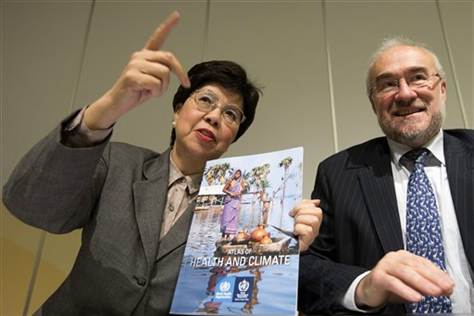New UN atlas links climate change, health
msnbc.msn.com/
GENEVA — Two U.N. agencies have mapped the intersection of health and climate in an age of global warming, showing that there are spikes in meningitis when dust storms hit and outbreaks of dengue fever when hard rains come.
Officials said Monday that their "Atlas of Health and Climate" is meant to be a tool for leaders to use to get early warning of disease outbreaks.
Though the data or conclusions aren't necessarily new, the way in which they are presented may sharpen governments' ability to respond to the threats posed by rising temperatures and changing climate.
Since 2005, for example, the atlas shows that the weekly number of cases of meningitis, which is spread by bacteria and germs, has risen when the dry season hits sub-Saharan Africa, where it has killed an estimated 25,000 people over the past 10 years. And since at least 1998, there has been a strong seasonal pattern of dengue fever, transmitted by mosquitoes, during periods of heavy rainfall in tropical and subtropical areas, killing about 15,000 people a year.

Director General of the World Health Organization (WHO) Dr. Margaret Chan, left, and Secretary-General of the World Meteorological Organization (WMO) Michel Jarraud pose for the media with the Atlas Of Health And Climate, a manual which provides a practical guide to "climate-sensitive diseases" that decision-makers and leaders can use as a tool for prevention, during a presentation for the media at the International Conference Center in Geneva, Switzerland, Monday, Oct. 29, 2012. (AP Photo/Keystone/Salvatore Di Nolfi)
The joint project of the World Health Organization and World Meteorological Organization, both based in Geneva, says the likelihood of increasingly frequent heat waves hitting the planet is four to 10 times as often by 2050 — and they will probably most affect the fast-growing vulnerable populations of aging and urban people particularly in Africa, the Middle East and Asia.
"Many diseases including malaria, dengue, meningitis — just a few examples — these are what we call climate-sensitive diseases, because such climate dimensions for rainfall, humidity and temperature would influence the epidemics, the outbreaks, either directly influencing the parasites or the mosquitoes that carry them," said Dr. Margaret Chan, the director-general of the U.N. health agency.
Chan said the data could be used to better manage animals' habitat and ecosystems, which would also make a big difference to people's health because 80 percent of the infectious diseases currently found in humans have come from animals.
WMO Secretary-General Michel Jarraud said the atlas is meant to translate and map information buried in the agencies' technical documents "into something which can be used by the decision-makers directly."
Copyright 2012 The Associated Press. All rights reserved. This material may not be published, broadcast, rewritten or redistributed.
